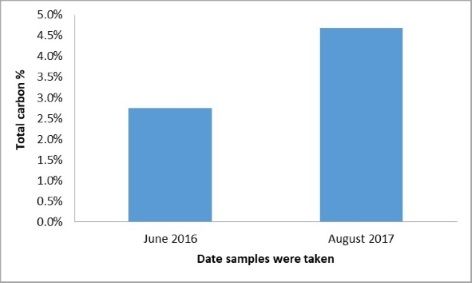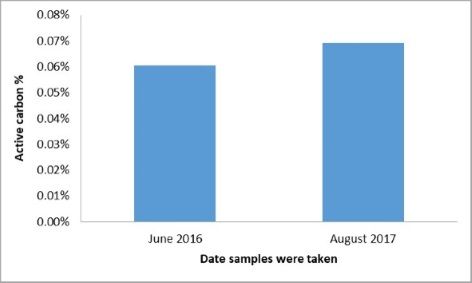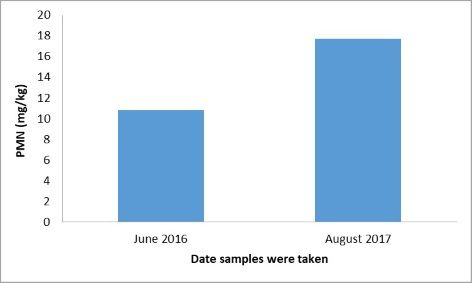I recently visited a farm manager to give him feedback on the soil health status of his pastures. I was really pleased to have seen an improvement in his current soil health status compared to the previous year when soil samples were taken. Soil health is the ability of the soil to perform its function, which is to sustain plant, animal and human life. There are many indicators of soil health which we measure, but for the purpose of this blog, I will focus on the three main indicators that have shown improvement in terms of soil life. An improvement in the soil life indicators namely total carbon (total C), active carbon (active C) and potential mineralisable nitrogen (PMN) give an indication of the improvement of the health of the soil.
Carbon contributes to the improvement of soil health in various ways, but some of the most important ones include improving soil structure, allowing nutrients to be held better and providing energy to soil micro-organisms. These micro-organisms further assist in making nutrients available to the pasture. Active C, which is a fraction of the total C in the soil, also has many benefits to soil health. One of the benefits is that it is a source of carbon that does not need a lot of effort to be broken down in order to gain energy from it. The active C level in the soil is an indication of the activity of soil micro-organisms that are decomposing organic matter and in the process providing available nutrients to the pasture. The process of mineralisation, measured by PMN, is beneficial to soil health. This process involves the conversion of unavailable forms of nitrogen to available forms through the action of micro-organisms. The available forms can be used by the pasture. All these indicators have the benefit that they support natural soil processes that make nutrients available to the pasture. This in turn can cause the farmer to reduce his fertiliser usage, lowering his environmental impact and saving money.
I believe an improvement in soil life indicators on the farm have been the result of the manager putting in an effort to improve his soil health management on the farm. Total C increased from an average of 2.7% in 2016 to 4.7% in 2017, which is an overall improvement of 1.9%. The improvement be seen in the graph below.
Improvement in total carbon levels from 2016 to 2017 on a farm in the Tsitsikamma
Active C also improved on the farm with an average of 0.06% in 2016 to 0.07% in 2017, which is an increase of 0.01%. This increase in active C shows that changes in soil management have had a positive impact on the health of the soil on the farm.
Improvement in active carbon levels from 2016 to 2017 on a farm in the Tsitsikamma
The PMN levels has also improved from an average of 11mg/kg in 2016 to 18mg/kg in 2017, an improvement of 7mg/kg. This could have a positive impact on the environment if less chemical nitrogen fertiliser is used. The potential loss of nitrogen, a pollutant to the environment, could be reduced.
Improvement in PMN levels from 2016 to 2017 on a farm in the Tsitsikamma
It is clear from the evidence presented that the farm manager has improved the health of the soil on the farm. How did he actually go about achieving this improvement? I believe the following actions have been the key to his success:
- He fertilises his soil with the correct amount and type of nutrients that are needed
- He applies humates with his fertilizer to soften the impact of the fertiliser on the soil micro-organisms
- He grows more pasture with more roots that add more organic matter to the soil
- He spreads dairy effluent, which is rich in nutrients and organic matter, back onto his pastures
- He stimulates his soil life by adding effective soil micro-organisms
- Chicory was planted into the pastures to add a diversity of roots in the soil, thereby increasing soil organic matter and soil microbial diversity
The positive impact of these actions on the environment should also be noted. Here are some examples of how the environment has benefited in a positive way:
- An improvement in soil carbon, causing carbon to be stored in the soil, reduces the amount of atmospheric carbon
- Healthier soil stores nutrients better and prevents the loss of nutrients to surface and underground freshwater sources and/or the ocean, where these nutrients cause pollution
- The soil water holding capacity improves with the build-up of carbon and therefore this precious resource is conserved much better in the soil
- The need for chemical fertilisers is reduced, resulting in a reduction in the greenhouse gases associated with producing and spreading them
This blog is an example of a farm manager who has made a concerted effort to adapt his soil health management strategy in order to improve his soil health. Fortunately this farm manager is not the only one with a passion for improved soil health management. There are many more farmers’ success stories (e.g. A soil carbon success story, A carbon footprint success story, Using minerals efficiency: Tsitsikamma dairy farm case study) like this where soil health indicators have been improved through soil health management changes. Are they not the type of farmers that you as consumer would like to support? I believe we should support them and celebrate the fact that they are putting practices into place that improve the quality and quantity of the agricultural products that they provide, while taking the environment into account.
- Milk, is it really just milk or so much more to it? - 2018-05-25
- Upside down thinking - 2018-04-19
- Happy soil life, happy grass, happy cows - 2018-04-04



